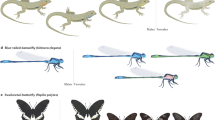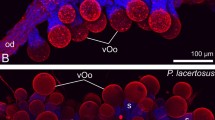Abstract
SINCE 1924, Joyet-Lavergne,1 working with plants and Protozoa, has been developing the view that in general female sexual cells are more reducing than male as judged by their effects on the colours of dyes; recently2 he considers that they contain more reduced glutathione because they give the colour reactions of this substance more strongly. In 1922, Manoilov3 developed a ‘test for sex ’in plants by an elaborate treatment of dyes of the rosaniline series as a result of which the female side was made to display the deeper colour, that is, the reverse of the Joyet-Lavergne effect; Satina and Demerec4 have confirmed and developed this test, applying it to animal tissues, and amongst others to the cladoceran Crustacea Moina and Daphnia.5 More recently, Falk and Lorberblatt,6 working again with animals (mammalian ovary and testis), have demonstrated that the test depends on an oxidation phenomenon, the more complicated Manoilov technique being replaceable by the oxidation of colourless p-leucaniline in the presence of sufficient ferric chloride by which the female side again produces the deeper colour of p-rosaniline and is therefore apparently more oxidising than the male; Falk and Lorberblatt also report an “interesting parallelism’ in that the extract of testis which they used was found to have considerable reducing power as shown by Tunnicliffe's method of estimating glutathione7 whilst the ovarian extract had none, and Sir Frederick Hopkins tells me that this disparity has been long familiar to him.
This is a preview of subscription content, access via your institution
Access options
Subscribe to this journal
Receive 51 print issues and online access
$199.00 per year
only $3.90 per issue
Buy this article
- Purchase on Springer Link
- Instant access to full article PDF
Prices may be subject to local taxes which are calculated during checkout
Similar content being viewed by others
References
P. Toyet-Lavergne, C.R. Ac. Sci., Paris, 179, 1212; 1924.
P. Toyet-Lavergne, C.R. Ac. Sci., Paris, 184, 1088; 1927.
E. O. Manoilov, Bull. Appl. Bot. Plant-Breeding, 13(2), 503; 1922.
S. Satina and M. Demerec, Science (New York), 1925, p. 225.
S. Satina, Proc. Soc. Exp. Biol. Med., 22, 466; 1925.
K. G. Falk and I. Lorberblatt, Brit. Jour. Exp. Biol., 4, 305; 1927.
H. E. Tunnicliffe, Bioch. J., 19, 194; 1925.
Author information
Authors and Affiliations
Rights and permissions
About this article
Cite this article
PERKINS, M. The Manoilov and other ‘Chemical Sex Reactions’. Nature 120, 654–655 (1927). https://doi.org/10.1038/120654a0
Issue Date:
DOI: https://doi.org/10.1038/120654a0
This article is cited by
-
On the sex in bonellia viridis
Acta Biotheoretica (1968)
-
Physiological aspects of sex in angiosperms
The Botanical Review (1938)
-
Une étude complémentaire sur la physico-chimie de la sexualité
Protoplasma (1933)
Comments
By submitting a comment you agree to abide by our Terms and Community Guidelines. If you find something abusive or that does not comply with our terms or guidelines please flag it as inappropriate.



